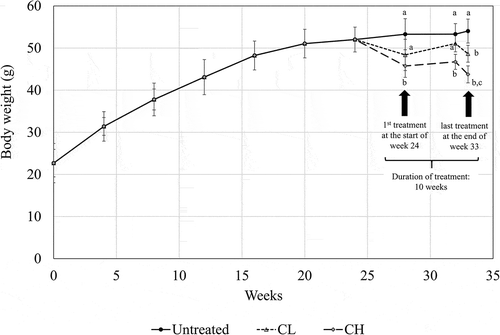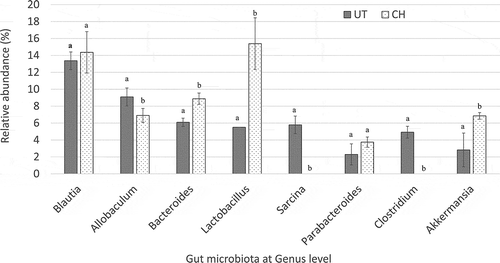Figures & data
Table 1. Grouping of the high-fat-diet (HFD) induced obese mice according to treatment.
Table 2. Primer sequences used in the quantitative real-time polymerase chain reaction assay.
Table 3. Body weight, fat-pad weight, and fat-pad/body weight ratio of untreated (UT), 0.08 ml/kg body weight (BW) coconut water vinegar (CL) and 2 ml/kg BW coconut water vinegar (CH)-treated high-fat-diet (HFD)-induced obese mice at the end of week 33.
Figure 1. Body weight measurement (week 0–33) of untreated mice and mice fed 0.08 ml/kg body weight (BW) coconut water vinegar (CL) or 2 ml/kg BW coconut water vinegar (CH). Data are shown as the average of biological replicates of mice from the same treatment group. Different letters indicate significant differences among groups (p < 0.05).

Table 4. Serum biochemical profile of untreated (UT), 0.08 ml/kg body weight (BW) coconut water vinegar (CL) and 2 ml/kg BW coconut water vinegar (CH)-treated high-fat-diet (HFD)-induced obese mice.
Figure 2. (a) Quantitative polymerase chain reaction analysis of obesity-related genes [glucose transporter type 4 (Glut4), adiponectin, and sterol regulatory element-binding protein-1 (SREBP1)] of untreated (UT) mice and mice fed 0.08 ml/kg body weight (BW) coconut water vinegar (CL) or 2 ml/kg BW coconut water vinegar (CH). (b) Significant adipokines down-regulated by coconut water vinegar treatment in high-fat-diet obese mice tested using adipokine proteome profiler analysis. RBP4, retinol-binding protein-4. Data are presented as the mean ± SD of biological replicates of mice from the same treatment group. Different letters indicate significant differences among groups (p < 0.05).
![Figure 2. (a) Quantitative polymerase chain reaction analysis of obesity-related genes [glucose transporter type 4 (Glut4), adiponectin, and sterol regulatory element-binding protein-1 (SREBP1)] of untreated (UT) mice and mice fed 0.08 ml/kg body weight (BW) coconut water vinegar (CL) or 2 ml/kg BW coconut water vinegar (CH). (b) Significant adipokines down-regulated by coconut water vinegar treatment in high-fat-diet obese mice tested using adipokine proteome profiler analysis. RBP4, retinol-binding protein-4. Data are presented as the mean ± SD of biological replicates of mice from the same treatment group. Different letters indicate significant differences among groups (p < 0.05).](/cms/asset/f2d5cac6-5846-4b36-a286-6f0b325ba343/zfnr_a_1368322_f0002_b.gif)
Figure 3. (a) Nitric oxide (NO) content and (b) quantitative polymerase chain reaction analyses of inflammation related genes [nuclear factor-κB (NFκB) and inducible nitric oxide synthase (iNOS)] of untreated (UT) mice and mice fed 0.08 ml/kg body weight (BW) coconut water vinegar (CL) or 2 ml/kg BW coconut water vinegar (CH). Data are presented as the mean ± SD of biologically replicated mice from the same treatment group. Different letters indicate significant differences among groups (p < 0.05).
![Figure 3. (a) Nitric oxide (NO) content and (b) quantitative polymerase chain reaction analyses of inflammation related genes [nuclear factor-κB (NFκB) and inducible nitric oxide synthase (iNOS)] of untreated (UT) mice and mice fed 0.08 ml/kg body weight (BW) coconut water vinegar (CL) or 2 ml/kg BW coconut water vinegar (CH). Data are presented as the mean ± SD of biologically replicated mice from the same treatment group. Different letters indicate significant differences among groups (p < 0.05).](/cms/asset/83bae8c2-5a48-4231-b6b4-50f3e74c6084/zfnr_a_1368322_f0003_b.gif)
Figure 4. Comparison of the relative abundance of gut microbiota at genus level of untreated (UT) mice and mice fed 2 ml/kg body weight coconut water vinegar (CH) at the end of week 33 post-experiment using Illumina 16S rRNA metagenomic sequencing. Data are presented as the mean ± SD of biologically replicated mice (n = 6) from the same treatment group. Different letters indicate significant differences between groups (p < 0.05).

